|
AN INTERVIEW WITH
JACK K. HALE
-- by Yingfei Yi
November 18, 2003 in Atlanta
|
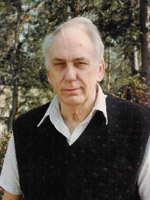 |
| Jack in his
backyard in Atlanta, June 1992. |
Foreword
Professor Jack K. Hale
is a world renowned leader and among the most influential persons
in the field of nonlinear dynamics in our age. He was an originator
and pioneer in many important areas in the interface of dynamical
systems and differential equations including nonlinear oscillations,
stability and bifurcation theory, functional differential equations,
and infinite-dimensional dynamical systems defined by
parabolic and hyperbolic equations. Professor Hale's seminal work and
leadership have played an important role in the development of
these areas which are now widely studied and are being
acknowledged as some of the most important branches of
mathematics today. Professor Hale's
influence in the field has gone far beyond his papers and books.
By being a leading mathematician and a
person of exemplary character, he has had
tremendous impacts on the career
developments of many people around him and has brought the best
out of many of us working in the field.
It seems only fitting that we begin
the very first interview of the SIAM DSWeb Magazine
with Professor Hale.
This interview is authorized by Professor Hale to
publish on-line
exclusively in the SIAM DSWeb Magazine. The published
version of the interview has been proof-read by
Professor Hale.
A brief biography of Professor Hale
Professor Jack K. Hale was born in Kentucky, USA, on October 3, 1928. He
received his B.A. degree in Mathematics from Berea College in 1949, and
the M.Sc. and Ph.D. degrees in Mathematics, in 1951 and 1953, respectively,
from Purdue University.
From 1954-57, Professor Hale worked as a Systems Analyst at Sandia Corporation.
From 1957-58, he was a Staff Scientist at Remington Rand Univac and was involved in
numerical analysis and the design of logic computers. From 1958-64, he was
a permanent member of the Research Institute for Advanced Studies (RIAS) in
Baltimore, Maryland. He joined the faculty at Brown University
in 1964 as a Professor in the Division of Applied
Mathematics for 24 years until 1988 and served
as a Division Chair from 1973-76
and Director of the Lefschetz Center for Dynamical Systems
for several years.
He came to Georgia Institute of Technology (Georgia Tech) in 1988
as a Professor and was named a Regents' Professor in 1990
in the School of Mathematics.
He was a co-founder of the Center for Dynamical Systems and Nonlinear
Studies (CDSNS) at Georgia Tech and served as Director of the CDSNS from
1989-1998.
Presently, he is a Regents'
Professor Emeritus
at Georgia Tech.
Professor Hale has written 15 books, over
200 research papers, and has supervised 48 Ph.D.
students and numerous post docs. He has been a Chief Editor of the Journal of
Differential Equations since 1981 and an editor of
nine other high-level mathematical journals. He has given numerous
plenary lectures and invited addresses at professional conferences
including Equadiff (1962, 1973, 1987, 1989, 1991, 1993), the
International Congress of Mathematicians (ICM, 1966), Louvain Summer
School (1976), SIAM conference (1985, 1990), and meetings of
the American Mathematical Society
(1981, 1985), the Australian
Mathematical Society (1977, 1993), the Canadian Mathematical Society (1985,
1993), C.I.M.E. (1972,
1974, 1983), and the Conference
Board of Mathematical Sciences (1980). He has provided extensive services to
the international mathematical community.
Professor Hale's professional accomplishments and contribution to the
international
mathematical society have been acknowledged with the highest academic
distinctions. Among these are
Honorary Doctorate Degrees from Universiteit Gent, Belgium (1982),
Universität Stuttgart, Germany (1988),
Instituto Superior Técnico Lisboa, Portugal (1991), Universität
Rostock, Germany (1998) and Clark
University, USA (2000). He is a Fellow of the American Academy of Mechanics since
its founding, a Corresponding Member of the Brazilian Academy of
Science (1979), an Honorary Fellow of the Royal Society of Edinburgh,
Scotland (1987), and a Foreign Member of the Polish Academy of
Sciences (1992). He received the Distinguished Alumnus Award
from Purdue University (1991) and from Berea College (1992). He received
the Chauvenet Prize (1965), Guggenheim Fellowship (1979-80), British Carnegie
Fellowship (1986), McFarland Fellowship (1988-92), and the Sigma Xi
Sustained Research Award at Georgia Tech (1991).
He was a Guest of the Japanese Society for Promotion of Science
(1976-77), the Rothschild Visiting Professor at the Isaac Newton
Institute, University of Cambridge (1995), and the Kloosterman
Professor at the Lorentz Center, University of Leiden (1997).
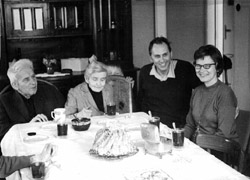 |
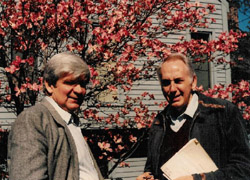 |
| Jack and Hazel at the home of the father of Czeslaw, in Pincow, Poland, spring 1972. |
Jack with Czeslaw Olech outside his home in Providence, mid 1980's. |
The interview
(H = Jack Hale, Y= Yingfei Yi)
Y: Jack, thank you for your time with this interview for
the SIAM DSWeb magazine. As a leader and a pioneer in many
areas of dynamical systems, especially those related to
differential equations, you have witnessed the entire development
of modern dynamical systems. Your experience and views will
certainly be valuable to those, especially younger ones,
working in these areas. Below, I am going to ask you some questions
about your career, experience, and your views on the areas,
which I think would be of interest to our readers.
H: It is an honor to be asked to have this interview.
I am glad to answer, to the best of my ability,
any questions. Of course, the answers will reflect mostly
my own personal experiences.
Y: I know you got your Ph.D. from Purdue (University) in 1953 with Professor Lamberto Cesari
and you wrote your thesis on nonlinear oscillations. How did you become a
student of Lamberto Cesari and what made you decide to do dynamics?
H: At that time at Purdue, there was very little opportunity
to study differential equations and there was no course of the
type that we see today dealing with qualitative questions.
I had finished my preliminary exams and was ready to begin
working with some professor. Lamberto Cesari had been at Purdue
about a year, I had not taken any course with him and
it did not occur to me to work with him because his
interest was in surface area and calculus of variations.
I was reading in the library one day and Lamberto Cesari came to
me and asked if I would like to work with him on differential
equations. He had done some work
in the 1930's on stability of linear systems
and had a contract to publish a book
with Springer. Therefore, he wanted some students
who would help him with the project. Having an interest
in engineering and physics, I accepted.
Y: I can imagine that, with few references available, to get things
off the ground must have been pretty tough.
H: At that time, the mathematical community in the US
had very little interest
in differential equations. I did not know of any serious book in
the subject. However, after I had essentially finished
my thesis, I discovered the 1947 notes of Lefschetz and the
book of Minorsky on nonlinear oscillations. It was much later
that I discovered the extensive research
that the Russian mathematicians had been doing since the time
of Poincaré and Lyapunov.
When Lamberto Cesari asked
me to work with him, I informed him that I knew almost nothing
about differential equations. His reply: `Don't worry. We will
learn the subject together by reading the original work of
Poincaré and Lyapunov.' This was like a reading course and
was the best thing that happened
to me because these two books laid the foundation for the
present theory of differential equations. It also made it
easy for me to read the Russian literature of the 1950's.
Y: Is your research experience in nonlinear oscillations the main reason
for you to become interested in engineering problems after your Ph.D.?
H: As I mentioned
before, I had a deep interest in engineering and physics.
I also was interested in nonlinear analysis and the role
of eigenvalues in the behavior of systems.
For the public lecture that was required of all Ph.D. students
at Purdue, I made use of a visual aid consisting of a real system,
designed by an
engineering professor, which would excite the first five
modes of a steel bar. After the Ph.D., since there was almost
no literature on nonlinear oscillations in mathematical journals,
my reading was primarily in engineering journals.
Y: I know you joined the research group led by Lefschetz at RIAS
in 1958 as a permanent member. How was this group formed, what was its main
function, and who were among the initial members?
H: As you know, Lefschetz was originally an engineer and turned
to mathematics after a serious accident which destroyed both
lower arms. Of course, he is famous for his contributions to
topology, but he had the background to keep abreast in
subjects not in the mainstream of mathematics at that time.
He was one of the few people in the US who was somewhat
familiar with the contributions of the Russian community
to differential equations and dynamical systems. He was
responsible for bringing much of the Russian literature
to the attention of the `Western' countries.
The following remarks about Lefschetz and RIAS may not be
completely correct, but I think that they contain the
essential ideas.
Lefschetz did not start RIAS. It was already a research institute,
but did not have a special group devoted to mathematics.
After Sputnik was put into orbit, Lefschetz became very concerned
about the fact that differential equations and dynamics was
not a subject which was being pursued with vigor in the US.
Robert Bass was working for the Martin Company at RIAS,
he knew Lefschetz from previous visits to Princeton
and also he was well versed in
differential equations. This gave Lefschetz a contact at
RIAS to attempt to form a group in differential equations
and control under the umbrella of the Martin Company.
The group was located in Baltimore about twenty miles from
the company and
had no obligations to the Martin Company except
to allow visitors from their various locations to spend
some time at RIAS, profiting in any way that they could.
There were a few permanent members of the group and
many temporary visitors from
around the world. This created an atmosphere in which
ideas were exchanged freely. This helped in coordinating
and accelerating the research in the subject, not only
at RIAS, but at the institutions of the visitors.
Most people in my age bracket working on the subject
spent some time at RIAS.
RIAS was also conveniently located near Johns Hopkins
University and the University of Maryland,
which gave the opportunity to have close
contacts with persons there. A journal, Contributions
to Differential Equations, was formed jointly with
the University of Maryland. It lasted only for a few years
and was the predecessor to the Journal of Differential
Equations which Prof. LaSalle began after we arrived
at Brown.
Conferences organized by RIAS in 1959 in Mexico and
1961 in Colorado Springs were to my knowledge the
first ones devoted to differential equations in the West.
There were visitors at these conferences from
Eastern Europe and Russia, which led to much
closer personal as well as professional contacts.
The original permanent members of RIAS were S. Lefschetz,
J.P. LaSalle, R. Bass, R. Kalman, H. Kushner, S. Schwartzman,
me, and, I think, J. Auslander and B. Rinehart.
As mentioned, there were always several visitors.
During our last year
in 1964, the number of people doing research was
approximately 30.
Y: You have given me a copy of your first book `Oscillations in Nonlinear Systems'
which was published in 1963. When
did you start working on the book and what was your motivation for writing it?
H: The material in this book had been an important part of my research
on nonlinear oscillations which I began in my thesis together with
the new knowledge
gained by reading much literature and my introduction to
invariant manifolds through Bogoluibov and Mitropolski. Many people
were working on nonlinear oscillations, but it was my feeling that
the engineers were not aware of much of the information that could
be of assistance in understanding some of their problems. I
felt strongly that they should be exposed to this information
and decided to write the book.
Y: Is it also at RIAS that you began to work on functional
differential equations (FDEs) and what was the status of the area back then?
H: My motivation for studying delay differential equations
came from the simple observation that delays occur in so
many engineering systems. At that time, there was almost
no serious effort on the part of engineers (Minorsky was
an exception) who would incorporate delays into their
models even though it was clear that they should be
there. There was much literature on linear systems and
some results on stability and instability of equilibria.
For a delay equation for \(x \in \mathbb{R}^n\), the analysis was
always restricted to analyzing the solution in \(\mathbb{R}^n\).
Such an approach was a severe limitation on the development
of any type of qualitative dynamics. Periodic solutions
did not look like closed curves, there was no hope for
something like a geometric classification of stable
and unstable manifolds of equilibria, etc.
I began to make progress after studying (in Russian)
the book of Krasovskii on stability. He made it clear
that one should consider the state space as the
function space consisting of the initial data on
a delay interval and then consider such
equations as evolutionary equations in this function
space. This approach changed the subject completely
and led eventually to the theory that we have today.
Y: How do you view the progress of FDEs as it is now, after
forty years of development, and what do you think the
future directions of the area should be?
H: There has been tremendous progress. The
qualitative theory began with retarded functional differential
equations with finite delay (RFDEs).
These were the simplest because the dynamical system becomes
compact after the time exceeds the delay. In addition to
showing that many of the results for ordinary differential
equations in \(\mathbb{R}^n\) (ODEs) are valid for RFDEs, new ideas
arose in trying to understand the global limiting
behavior of solutions. By exploiting this compactness,
the concept of a compact global attractor was introduced
for dissipative RFDEs in 1971. In my opinion, the
progress in RFDEs had a big influence on the development
of the qualitative theory of parabolic PDEs as we know
it today.
In the middle of the 1960's, a qualitative theory was also
initiated for a special type of neutral functional
differential equations (NFDEs) for which the derivatives
occur linearly and with delays. These equations do
not have the smoothing property and are more like
hyperbolic PDEs. The dynamical system generated by such equations
was shown in the late 1960's to have special properties, which were
special cases of asymptotically smooth dynamical systems.
With dissipation, these equations also have compact
global attractors.
Once these concepts were introduced, it led to many
natural questions about the finite dimensionality of
the attractor, the discussion of special types of
equations for which one could describe the flow
on the attractor, etc.
Some references for many more ideas are the books of
Hale and
Verduyn Lunel (Springer, 1993),
Hale, Magalhães
and Oliva (Springer, 2002), and Diekmann, van
Gils,
Verduyn Lunel, and Walther (Springer, 1995).
There is now
also a theory for partial functional differential
equations of
retarded type and the beginnings of a the theory
for
neutral type as shown in the book of Wu (Springer, 1996).
There are many challenging problems in all of these areas
as one can easily see by scanning the above references.
|
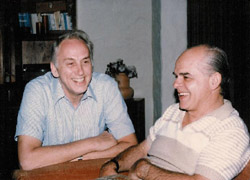 |
| Jack with Waldyr Oliva in Brazil, mid 1980's. |
Y: I noticed that during the 1970's, you begin your interests in
dynamics of PDEs and dissipative systems in general.
What was the area like in that period?
H: I became very interested in the fact that our work in FDE
was playing a role in a qualitative theory
of quasilinear parabolic PDEs, which Dan Henry, a former student
of mine, began to develop in 1971, culminating in his book in
1981. In the late 1970's, some of my students were working
in this subject.
I became even more interested when I encountered a nice paper
of Babin and
Vishik
(1983) on the existence of attractors
for linearly damped hyperbolic wave equations on a bounded
domain. Their definition of attractor was more restrictive
than the one we gave for NFDEs. It turned out that the theory
that we had developed for NFDEs worked equally well for
this situation and we could obtain the strong attractor.
The difficulties encountered by Babin and Vishik were of
similar nature to the ones we had encountered with NFDEs
in the 1960's.
My interest in the dynamics of PDEs continues.
Y: How do you view the importance of evolutionary PDEs as dynamical
systems and how do you
view the future directions of the area?
H: It is extremely important to develop the qualitative theory
of PDEs and to exhibit interesting classes of equations
for which we are able to understand the complete dynamics.
This has been accomplished for scalar dissipative quasilinear parabolic
PDEs on a bounded interval. The structure of the flow on the attractor
is completely understood. The complete understanding of such a simple
problem suggests the types of questions that should be
asked in more complicated problems.
It is very important to isolate classes of equations which will
exhibit new phenomena and, at the same time, to be amenable
to a complete understanding of the dynamics. Such systems
are beginning to appear in the literature dealing with
systems of PDEs. The nonlocal interaction in such equations
introduces many new phenomena. There is a considerable literature
now dealing with the qualitative theory of dynamical systems related to
parabolic systems, effects of cross diffusion, the Navier-Stokes equation, solitary
equations, and effects of time dependence in these systems. In modeling as well as numerics
of evolutionary PDEs, one
encounters lattice dynamical systems, an actively investigated area at
the present time.
Y: What other directions in the dynamics of differential
equations do you feel need more attention?
H: My own interests at the present time are in trying to understand
transition layers in singular parabolic problems, the role
of the shape of the boundary of the domain of definition
on the dynamics, the effects of time dependence in the equations.
I also would like to understand singular problems for which
the equation has parabolic structure and the singular limit
is hyperbolic. This seems to be a very challenging problem
which occurs very often in applications.
Y: Given the natural connections of dynamical systems with
many applied disciplines, what role do you think we mathematicians
should play when working on applied problems?
H: I have heard a conversation that someone
was having with Lefschetz where he was asked: `What is applied mathematics?'
Lefschetz replied that all mathematics is applied, some spelled with a capital `A' and some with a capital `M.'
I think that we gain many new ideas from studying applications but mathematicians should emphasize capital `M.' It is our obligation to discover the
mathematics and we
cannot
rely on the applied people to give us mathematical problems.
We must find them. Even though my work has always been on the
theoretical level, much of my motivation has come from applications.
Y: What is your standard for good research in dynamics of
differential equations or how do you value mathematical research in general?
H: The measure of good research has nothing to do with the field.
The things that I find most interesting are the ones that involve
some new ideas. Most of the papers that do not contain a new idea
but are just using standard things in an obvious way to improve
a result do not push the field forward very much. On the other
hand, such results may be beneficial in applications.
 |
I think that my research has been guided by
my own discovery of
something that seemed interesting and that I wanted to
understand. It did
not matter to me if other people were interested
or not. I was told several
times that what I was doing was
uninteresting. After many years, it turned
out that some of
the things were interesting. I guess that I was following
some advice given to me by Lefschetz at
RIAS, when I asked him if what I
was doing was of any interest.
His reply was: `Does it bother you?' Of
course, my answer
was yes. His answer was: `Then keep at it until it does
not bother you.'
To me, this is a good philosophy to follow. We should not
work on anything unless it excites us and results in
satisfaction.
|
| Jack Hale in his office at Brown in 1988 after the celebration for his 60th birthday. |
Y: What is your advice for young persons who wish to begin research
in dynamical systems?
H: At the beginning of a research career, it is very unusual
to be able to recognize fundamental problems. Therefore, we
do what we can, which is usually to make small modifications to
existing results. However, one should not continue to
do this and one must spend considerable energy in diversifying
his or her interest in other areas.
There is then the possibility of
recognizing something that one feels is fundamental and
to which he or she will be committed for several years.
Y: As you know, there is a global pressure on young persons to publish
papers and to obtain fundings. What is your opinion on this? And
what steps should the community as a whole take to help
improve the situation?
H: It is unfortunate that we have created an academic community
which requires to publish or perish. It has led to young people
focusing entirely on a subject which is directly related to
problems of their thesis and there has been no time to
either broaden their interests or delve deeply into the subject.
Promotions are often
based on the number or weight of publications
without critical evaluation of content. A person may only
publish one paper every two years, each of which is
excellent with many new ideas, but will be put lower
in the scale than a prolific publisher whose papers
have little content. One way of correcting this is
for the members of the academic community to take the job of
evaluation of personnel more seriously.
For a long time, external funding has been given to members of
the faculty of universities. This has allowed an increase
in the number of faculty, but has also made universities
dependent upon this external funding. As a result,
the direction of research is being determined by a few
members of the granting agencies who often have a very
focused view of what is important. It is not what
we usually consider to be a university where there is
complete freedom of research. There should be emphasis
at the university on scholarship and there should never
be a penalty based on external funding.
Y: What is your philosophy for being a good intellectual?
H: I think that my attitude toward research has been dealt
with before. As part of the academic community, our primary
job is to train young people. We should instill in the
student the excitement associated with learning and discovery.
We should always participate in the formation of policies
at our institution and we should serve the professional
community when asked.
Y: Let me change to a different subject. When the mathematical group at
RIAS moved to Brown in 1964, is that when the Lefschetz Center
for Dynamical Systems at Brown started?
H: No. We formed a Center for Dynamical Systems (CDS) with
Lefschetz, LaSalle, Kushner and myself coming from RIAS.
Other appointments were made soon after arriving.
The Center was named the Lefschetz Center in 1974 at
a special meeting at Brown that we had planned in his honor.
Unfortunately, he died two years before the meeting at the
age of 88.
The Center received some funding from the University and
we also secured some from external sources. At that
time and for several years later, it was possible to
obtain funding from the Defense Agencies to work
on fundamental problems in areas without specific
instructions to make a contribution in a special application.
Y: Were there other dynamical systems centers in the US during
that time?
H: Not to my knowledge.
Y: As a former director of the Lefschetz Center, how do you
view the role the Lefschetz Center played in the global
development of
dynamical systems; in particular, dynamics of evolution equations?
H: In my opinion, the Lefschetz Center made and is still making an
important
contribution to the development of dynamical systems. During
my tenure, there were
many excellent students who obtained their Ph.D. working with
members of the Center and are now professors at various
good universities inside and outside the US. The vitality
of the Center was also enhanced by an average of two
post-docs each year and the many
visitors who came with their own funding. I can say that many
directions in dynamical systems were influenced
in a significant way by this program.
Y: You moved to Georgia Tech in 1988 with Shui-Nee Chow to start the
Center for Dynamical Systems and Nonlinear Studies. To what extent
do you feel an engineering environment like Georgia Tech has helped
the development of applied dynamical systems at the Center?
H: The interaction between mathematics and engineering and the
physical sciences
has been much more extensive at Georgia Tech than at Brown.
We have had many close interactions especially with
Aerospace, Electrical and Mechanical Engineering, Materials
Science and Physics. This interaction has had a very
positive influence on all parties. It is continuing and
should definitely be encouraged.
Y: You have been a director for two dynamical systems centers
in the US
for many years. In your view, what are the main factors leading to the
success of a center on dynamical systems?
H: I think that I have answered that before - strong people
working on good problems, good students,
regular communication through seminars,
and making sure that there is a program
involving long term visitors.
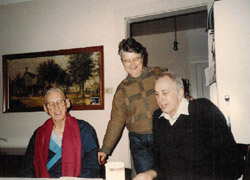 |
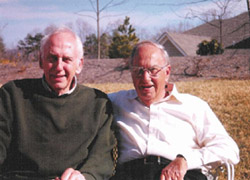 |
| Jack at his sister's home in 1988 with his father and Hazel. |
Jack with his brother Gene in 2003 at the home of Gene, in Charlottesville, Virginia. |
Y: Towards the end of this interview, I'd like to ask you something
more personal and I hope you don't mind.
H: It is okay.
Y: I know that you have had opportunities other
than being a professor when you were young. Some said that you even
had a good opportunity
to be extremely wealthy. Have you ever felt regret for choosing not to take
those opportunities?
H: Everyone always has the opportunity to choose several directions
for his or her professional career. After obtaining my Ph.D.,
I spent some years away from the university at Sandia Corporation
in Albuquerque, New Mexico, and Remington Rand Univac in St. Paul, Minnesota.
In St. Paul, I had the possibility to
become wealthy when friends in our department asked me to
join them in forming a new company, called Control Data.
I knew that we were not smart enough to make money and, of course,
I was wrong.
I was beginning to think that an academic career was more
appropriate for me. When Lefschetz asked me to be a permanent
member of RIAS, I did not hesitate and I have expressed to you
what a great influence this had on my future. Of course, there
are no regrets.
Y: What is your philosophy of life?
H: Try to be a responsible member of society, respect people
for what they are, have good friends and do every task to
the best of your ability.
Y: After you retired in 1998, you seem to be even busier. Do you feel
your life style has changed some after retirement?
H: The only change that I see is that I am not on any
university committees and
do not teach or have students. There is more time for
concentration on my research and writing. Retirement
also has made it possible for me
to spend more time with my wife, Hazel, and to
participate more in the things that she enjoys.
Y: What do you do in your spare time?
H: I have always liked to read and travel and, in retirement,
there is more time for this. Hazel and I
both enjoy theater, museums and `playing in the dirt' in our garden.
Y: What is your plan in the next few years with respect to your research
and other academic activities?
H: Professionally, I will probably be doing the same things that I
have always done - try to understand new things, communicate
things that I know through writing and lecturing.
Y: Well, Jack, thank you very much for sharing your life, your career
experience and your views with us. I am sure that our
readers will enjoy reading this interview. Finally, my best wishes to
you and Hazel. Please give my best regards to Hazel. She has been like a
mother to many of us and we all love her.
H: It was a pleasure.